
Blue Gemstones: A List of 33 Blue Gems
 From azurite to sapphire to blue zircon, blue gemstones seem to capture attention like no other. According to international surveys, blue is the most common favorite color. Blue is also the rarest color in nature!
From azurite to sapphire to blue zircon, blue gemstones seem to capture attention like no other. According to international surveys, blue is the most common favorite color. Blue is also the rarest color in nature!
Blue gems symbolize tranquility, honest communication, and devotion. As healing stones, blue gems are said to increase patience, soothe anxiety, and promote healthy, trusting relationships.
For centuries, blue pigments were expensive, thus reserved for the noble and wealthy. Many religions deemed blue as a sacred color, from adorning Mayan human sacrifices to the Christian Virgin Mary. The first synthetic pigment was “Egyptian blue,” created around 2500 BC by, big surprise here, ancient Egyptians.
Today, we have an abundance of blue items, including a surprising amount of blue stones and crystals, ranging from baby blues to deep midnight blues and everywhere in-between.

Which Gemstones Are Blue?
Blue Agate
Apatite
Azurite
Aquamarine
Benitoite
Blue Chalcedony
Chrysocolla
Blue Diamond
Dumortierite
Blue Fluorite
Grandidierite
Hawk’s Eye
Hemimorphite
Iolite
Blue Jadeite
Jeremejevite
Kyanite
Labradorite
Lapis Lazuli
Larimar
Moonstone
Blue Opal
Blue Pearls
Pietersite
Blue Sapphire
Shattuckite
Sodalite
Blue Spinel
Tanzanite
Blue Topaz
Blue Tourmaline
Turquoise
Blue Zircon
Now let’s go over each of these blue gems!
List Of Blue Gemstones
Find every blue gemstone name and meaning alphabetically below:
Blue Agate
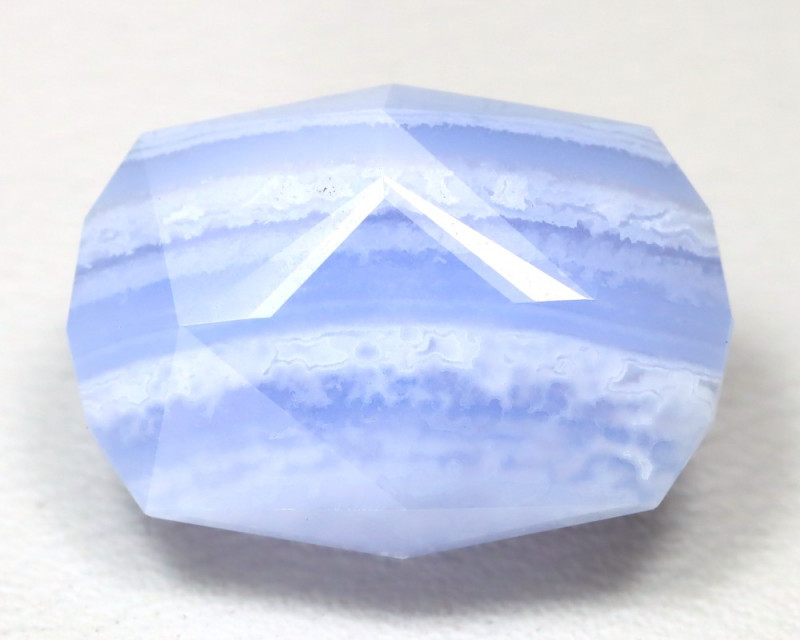
Agate is a chalcedony subgroup comprising translucent, banded or patterned varieties. The most popular blue type is blue lace agate, a relatively rare variety with swirls or bands of white, sky blue to lilac, and bright blue.
Blue lace agate beads or cabochons are popular, and these light blue gemstones are the official state gem of Nebraska, USA.
Like all blue gems in this list, blue agate can be used as a throat chakra stone, allowing you to better understand and express your truest self.
Apatite
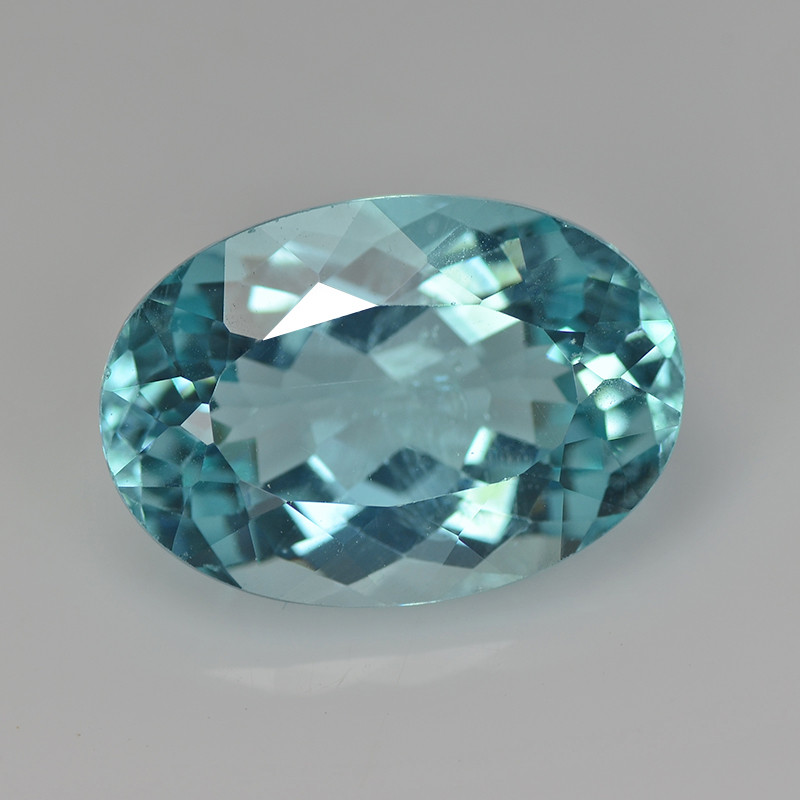
“Apatite” refers to a group of gems or an individual gem in that group. The stone’s colors are diverse, but the best known apatite jewelry comes in Caribbean blue or neon blue-green reminiscent of Paraiba tourmaline.
Mineralogically, apatite is the standard for 5 on the Mohs hardness scale.
Azurite

Azurite is a famously rich blue stone with historical significance as a blue pigment. One notable example is the Renaissance painting Madonna and Child Enthroned with Saints by Raphael.
The stone’s blue hue can vary between pale, vibrant, or dark. However, azurite’s color often weathers into green as it transforms into malachite. Many gems are combinations of both (azurmalachite), with the potential for sphere carvings resembling Earth.
Aquamarine

The first birthstone on our list, for March babies, is the legendary aquamarine, which dates back (in recorded history) to around 480-300 BC. This beryl variety is known for its range of soft to deep blues and blue-greens. Most are light greenish-blue.
What color aquamarine is most expensive? The most valuable aquamarines have intense, pure blue coloring. Heat treatments are common to reduce green tones.
What are the rarest blue stones? One of them is…
Benitoite
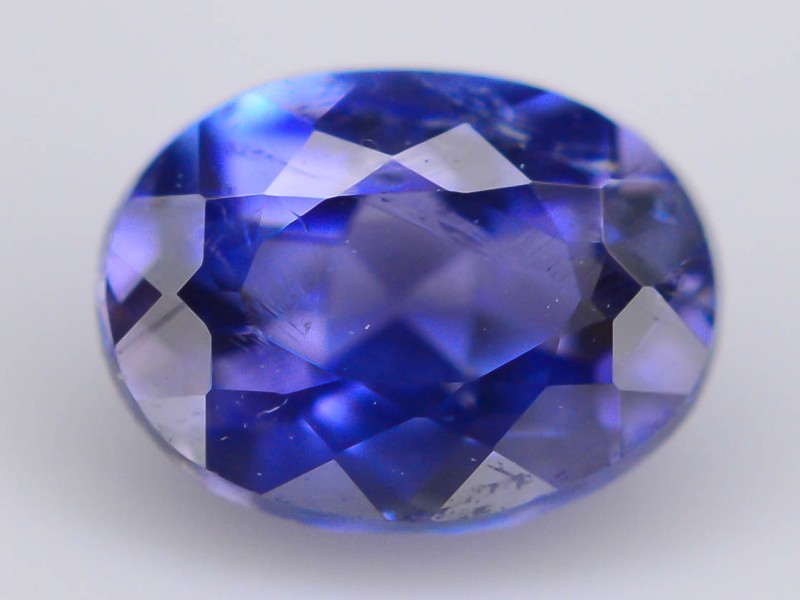
Not only one of the bluest gemstones, benitoite is also one of the rarest gemstones period. Why is benitoite so rare? This sapphire blue, violet-blue, or colorless gem is only found as gem-quality crystals in one California mine (San Benito) with around 300 carats produced per year.
Benitoite’s fiery sparkle (dispersion) also exceeds that of diamond (at a lower price), and the definitive origin of benitoite’s blue color remains a mystery, despite numerous studies.
Blue Chalcedony

Chalcedony encompasses a large group of microcrystalline quartz stones. Excluding agate, the blue varieties include:
Blue Chalcedony: Varieties simply labeled “chalcedony” are often translucent and solid-colored in blue, white, or violet blue hues.
Aquaprase: The newest discovered variety found in 2014, this stone is blue-green and sold as Aquaprase™ when natural, untreated, and distributed by Avant Chordia
Chrysocolla Chalcedony (Gem Silica): The most valuable chalcedony variety, this variety has bright blue-green and/or blue coloring from tiny chrysocolla inclusions.
Jasper: Though rare, occasionally blue jasper varieties are ocean jasper, kambaba jasper, and imperial jasper
Sources often name their specific blue chalcedonies, like “Mojave blue” from California, “African blue” from Namibia, or “holly blue” from Oregon.
Is blue chalcedony rare? Gem-quality pieces are uncommon. Natural, uniform, deep blue is the rarest chalcedony color.
Chrysocolla
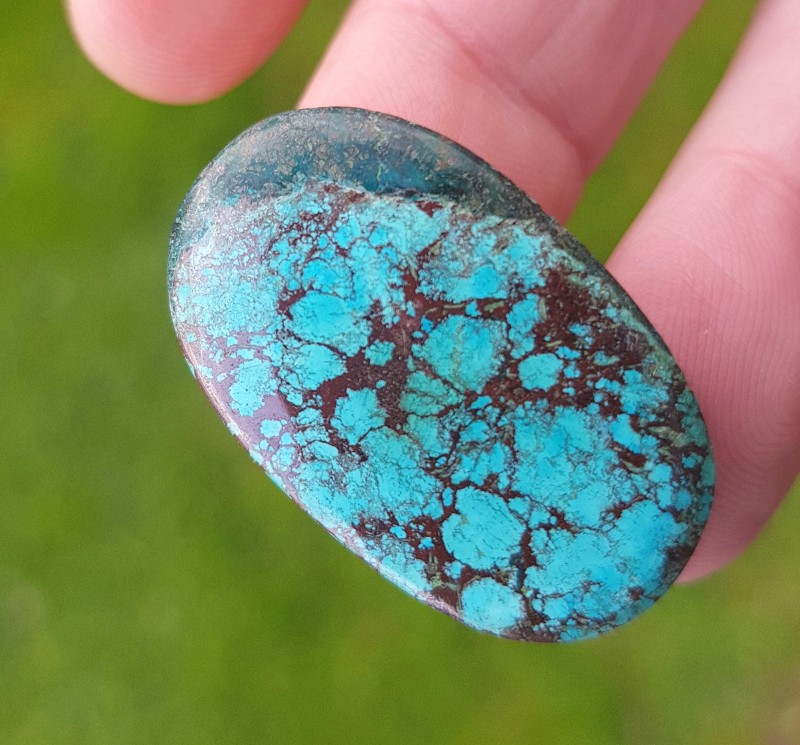
What is the light blue stone that looks like turquoise? You might be thinking of chrysocolla, a copper carbonate with blue to green coloring and often black streaking (which distinguishes it from turquoise).
Though soft, chrysocolla is an important copper ore and makes beautiful gems when mixed with other stones.
One important example is the Eilat stone, which contains chrysocolla, turquoise, and malachite (among other minerals). It’s Israel’s national stone and nicknamed the “King Solomon Stone.”
Blue Diamond
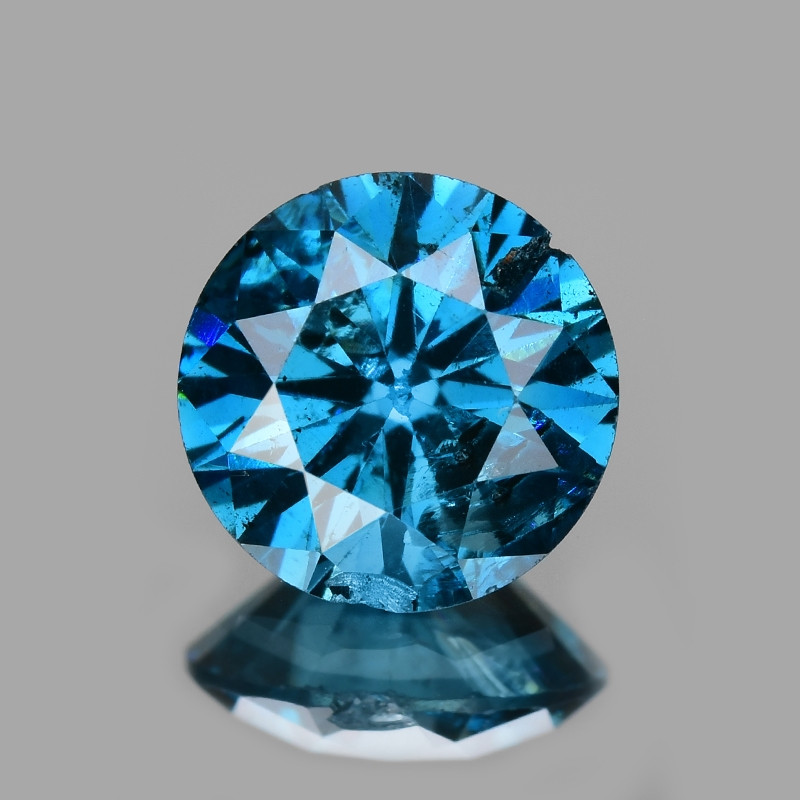
The gem of all gems, the diamond’s accolades precede it. But are blue diamonds a real thing? Yep, blue diamonds exist naturally. Though not the rarest diamond color, some of the priciest diamonds in the world are blue:
Hope Diamond: 3rd most expensive diamond, valued up to US $350 million (over $7 million per carat) as of March 2023
Oppenheimer Blue Diamond: 7th most expensive diamond, sold for US $57.5 million (over $4 million per carat) in 2016
Blue Moon of Josephine Diamond: 10th most expensive diamond, sold for US $48.4 million (around $4 million per carat) in November 2015
Of course, blue diamonds are still diamonds, meaning they’re also precious gemstones, April birthstones, and the traditional gem for 10th, 60th, and 75th wedding anniversaries, on top of being the hardest substance in the world.
Dumortierite
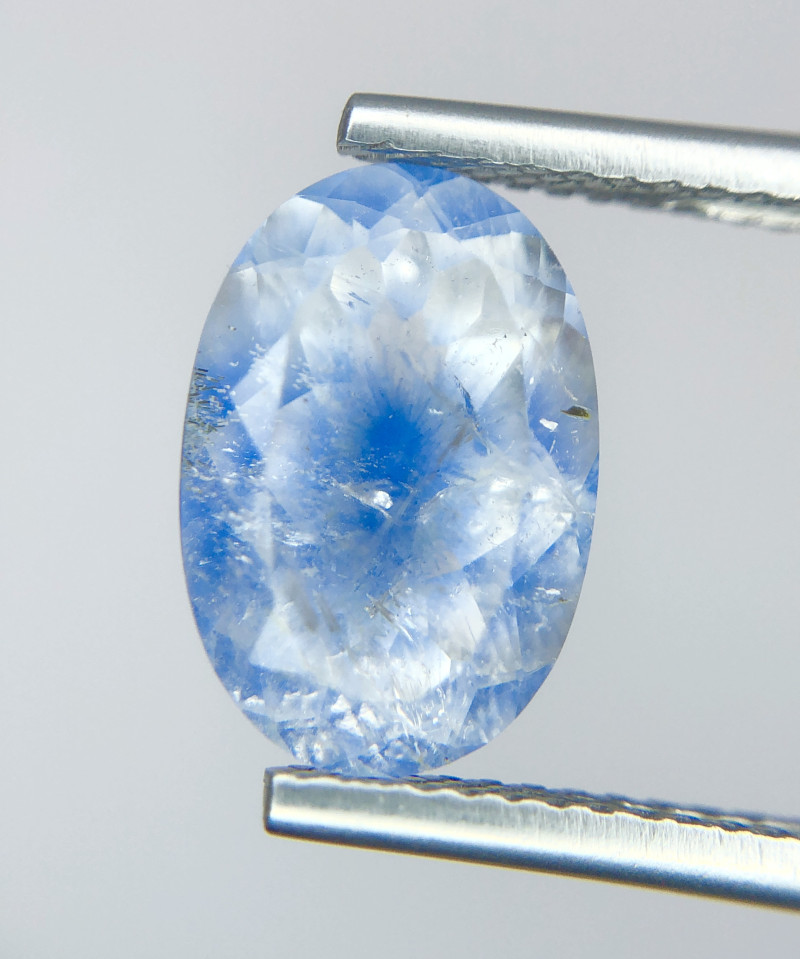 Pictured above: Dumortierite in quartz
Pictured above: Dumortierite in quartz
Dumortierite is a commonly blue, greenish-blue, or violet-blue borosilicate, though it can also be pink or red. “Blue denim stone” is a nickname for deep blue dumortierite.
A lesser-known gemstone, it’s better known for being what makes “dumortierite quartz” blue, as this type of quartz has various dumortierite inclusions.
Sometimes called “Bahia Blue Quartz” or “Blue Moon Quartz,” dumortierite quartz varies widely in appearance. Some specimens are clear with blue dumortierite needles (similarly to rutilated quartz) while the inclusions in other specimens resemble coral reefs.
The cause of dumortierite’s blue color isn’t fully agreed on.
Early theories said the blue comes from ferrous iron (Fe2+) and titanium (Ti4+) charge transfer. Later chemical analysis showed that colorless dumortierite had much higher magnesium content, so some scientists think this excess magnesium pairs with the titanium instead, so there isn’t enough titanium left to pair with iron and make the blue color.
Blue Fluorite
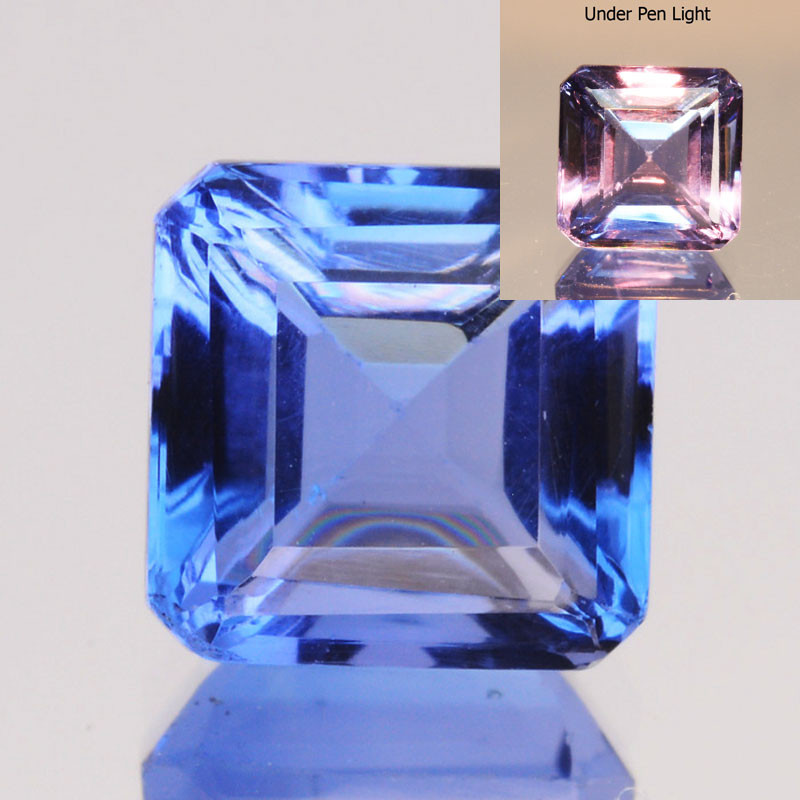
Fluorite is known for coming in the most colors of any mineral, but one rare, sought-after fluorite color is blue. Blue fluorite may be color-zoned, color-changing (shifting from blue or teal to lilac or green in different lighting), or a special type called “Blue John.”
“Blue John Stone” or “Derbyshire Spar” is a rare type of fluorite that only comes from the Treak Cliff Cavern and Blue John Cavern in Derbyshire, England. It has purplish-blue and yellow color banding.
Grandidierite
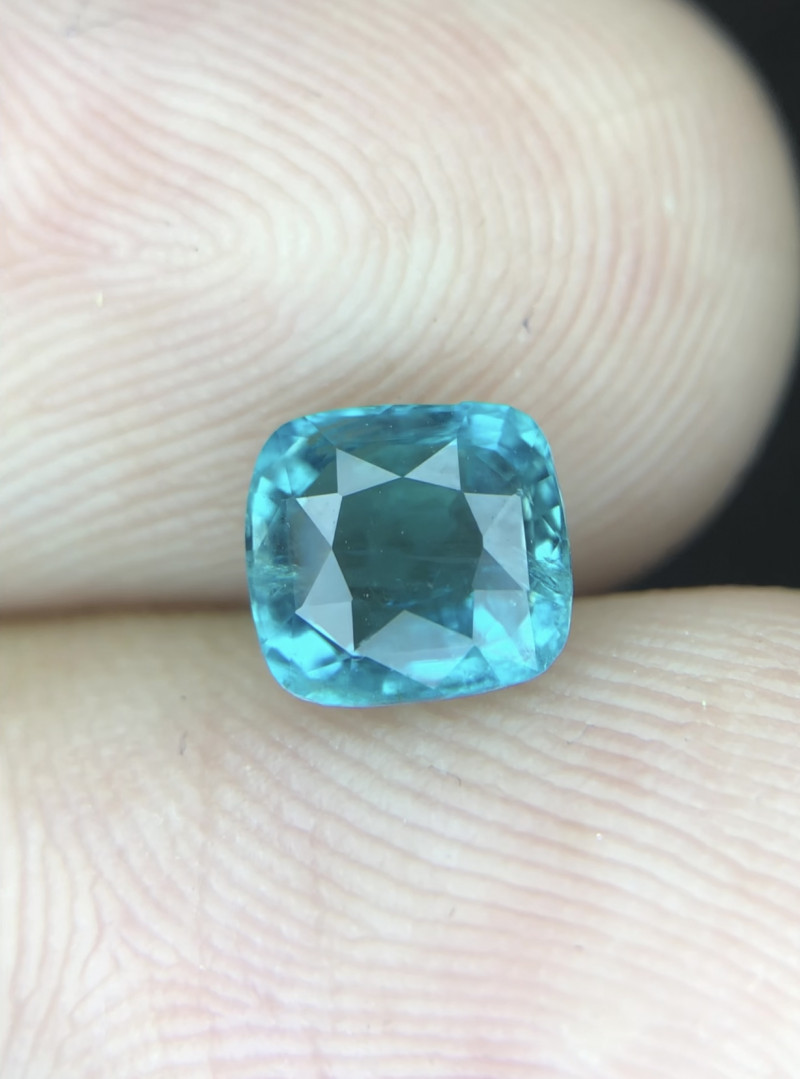
Like benitoite, grandidierite is among the world’s rarest gemstones. Grandidierite is an aquamarine-blue to sea-green gem, and higher iron content means more blue coloring.
The stone only occurs in shades of blue, blue-green, or green. However, it also has strong pleochroism (different colors at different viewing angles) in dark green, dark blue-green, and colorless or light yellow.
In terms of grandidierite’s price, the first transparent, faceted grandidierite fetched around $172,000 per carat, but good-quality faceted stones are generally $20,000 to $26,000 per carat. Cabochons are much more affordable.
Hawk’s Eye

Hawk’s eye is a titanium-blue to blue-green gemstone that’s technically a rock and quartz pseudomorph, as it starts as crocidolite (blue asbestos) that alters into quartz but remains fibrous.
Specimens stained by iron during formation become golden-brown tiger’s eye stones. As such, hawk’s eye is sometimes called “blue tiger’s eye.”
The fibrous structure gives hawk’s eye simple chatoyancy, an optical effect similar to the “cat’s eye” effect but instead of one reflected ray of light, there are multiple streaks of light.
Hemimorphite
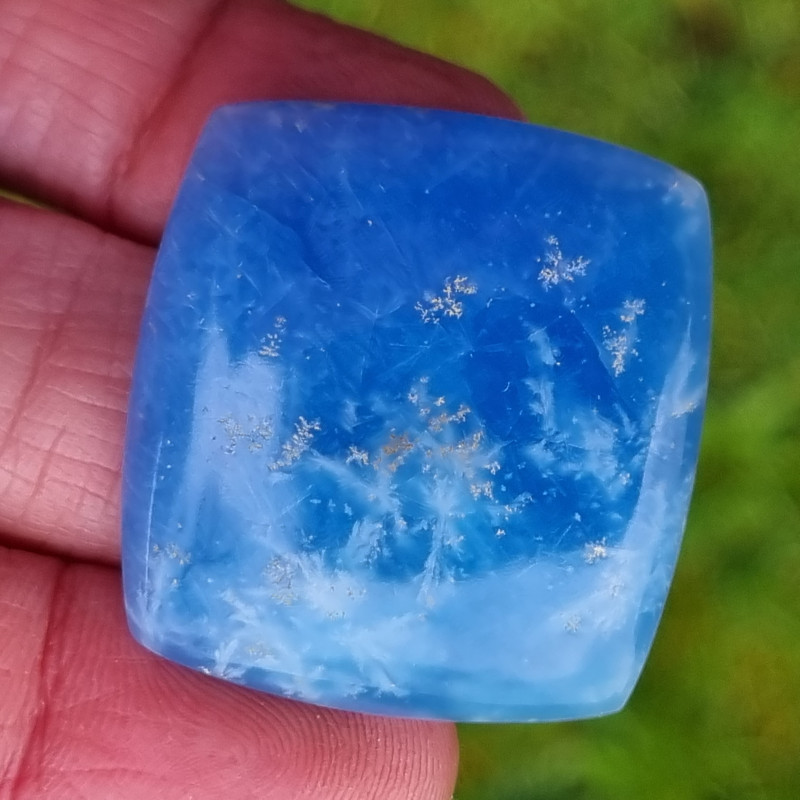
Hemimorphite is a rare, commonly white, gray, or brown mineral but its robin’s egg blue or bright blue forms are popular among collectors. There are more special properties besides hemimorphite’s color, though.
What is so special about hemimorphite? Its terminations (the vertical ends of the crystal). Instead of looking mostly the same on both terminations, hemimorphite crystals will be blunt and mostly one face on one end with a pyramidal, more pointed shape on the other. This is why it’s named from the Greek hemi, for “half” and morph, for “shape.”
Most hemimorphite specimens have some blue and white banding or mottling. Since solid blue hemimorphites are especially rare, some shady sellers will dye aragonite blue to pass as blue hemimorphite.
Additionally, hemimorphite is often mixed up with smithsonite, another similar-looking zinc ore.
Iolite
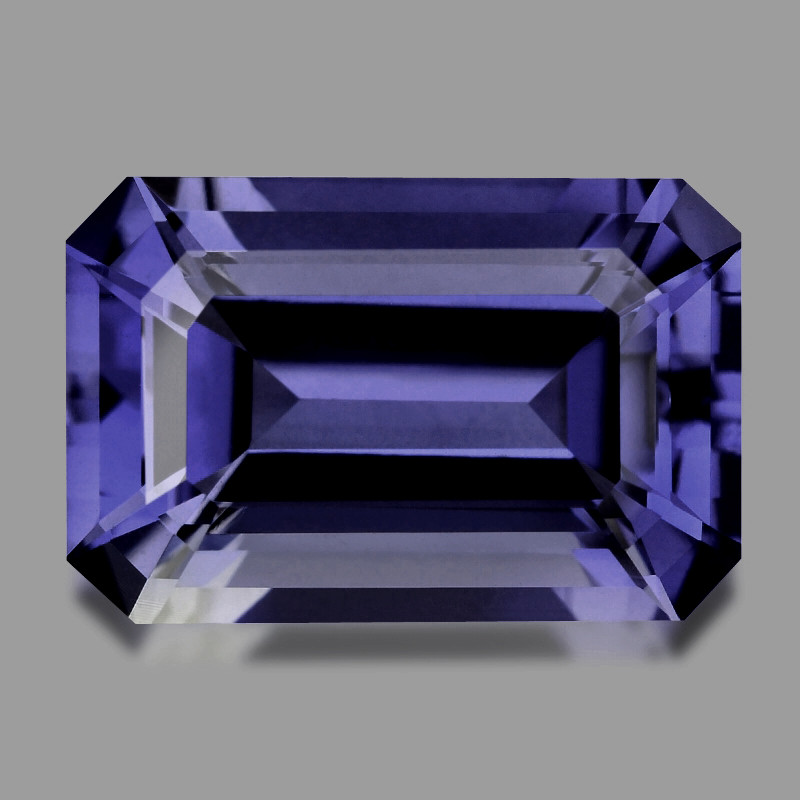
Though named after the Greek term ios, for “violet,” iolite is actually a violet-blue cordierite variety. The most valuable iolite colors are slightly violet blue and pure blue, caused by iron impurities. Other notable features are its strong trichroism (three pleochroic colors) and ability to sometimes display chatoyancy or aventurescence.
The most famous iolite origin is the legend that Vikings would have iolite for navigation at sea, using slices of it to find the sun (and thus their location) on overcast days.
In modern times, iolite is a zodiac stone for Sagittarius and the 21st wedding anniversary gem.
Blue Jadeite
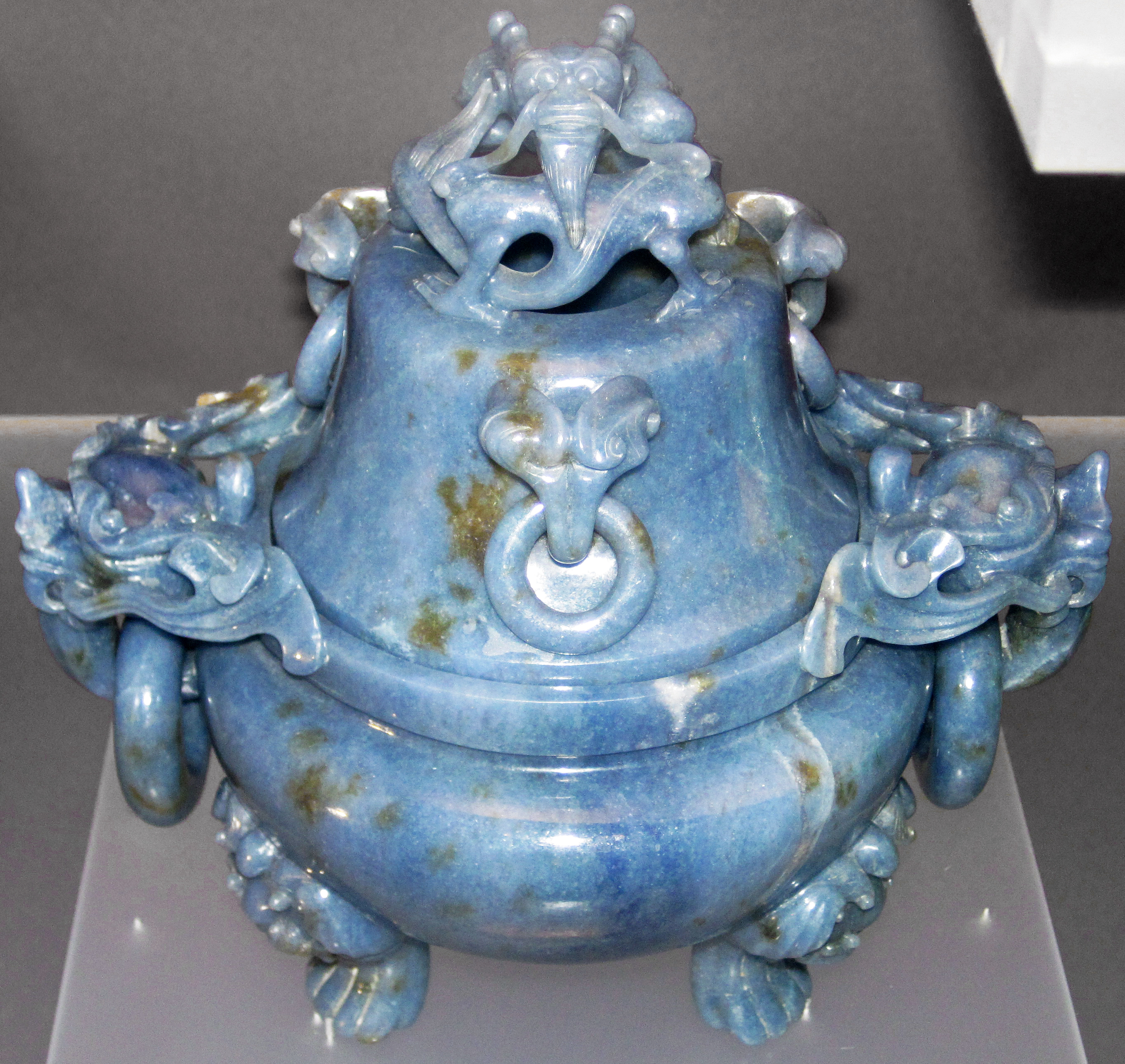 Pictured above: Blue jadeite Chinese incense burner from Qing Dynasty | Image credit: James St. John, CC-BY-SA-2.0
Pictured above: Blue jadeite Chinese incense burner from Qing Dynasty | Image credit: James St. John, CC-BY-SA-2.0
Jadeite is one of the two gemstones (along with nephrite) referred to as “jade.” Both nephrite and jadeite gemstones are best-known as green gemstones, but jadeite comes in a brighter and wider variety of colors. The rarest jadeite color, also not seen in nephrite, is blue.
What is blue jadeite? It’s a natural, rare jadeite that’s usually a milky blue, but it can also be medium blue or pale blue-green.
One famous type is “Olmec blue jadeite.” This translucent, watery blue jadeite (colored by titanium and iron) was revered by the Olmecs, the first Mesoamerican civilization that existed around 1600 to 400 BC. To the Olmecs, blue jadeite symbolized renewal, life, and growth, and ancient Mayans adopted this reverence.
Mayans guarded the jadeite sources until they died out, and it wasn’t until the 1970s to early 2000s that Olmec blue jadeite was rediscovered in Guatemala.
Jeremejevite
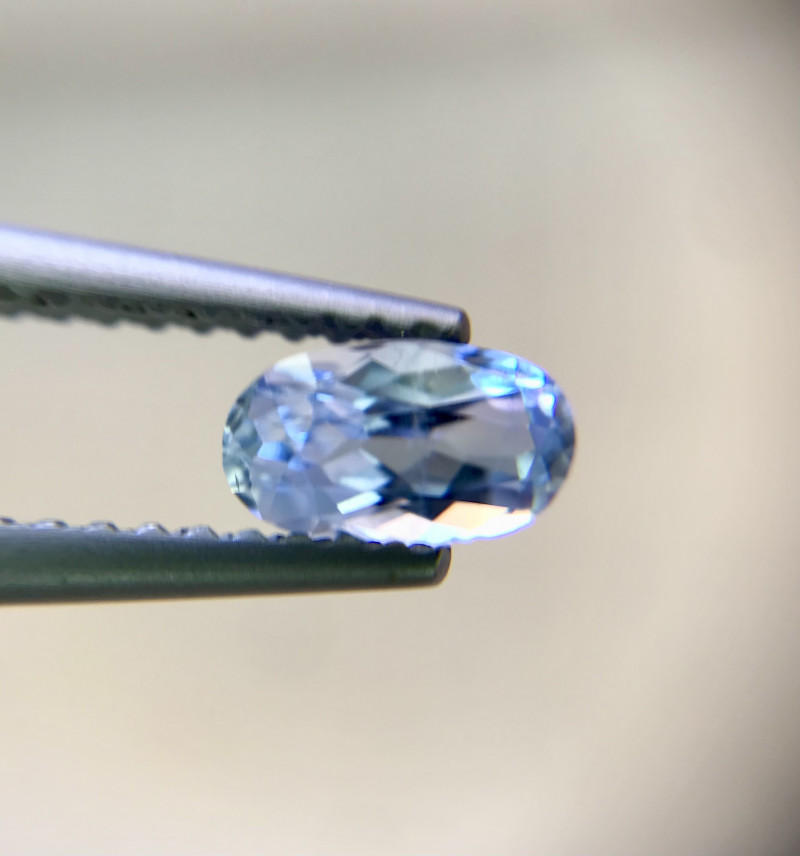
Jeremejevite (pronounced yer-ah-mee-YAY-vite) is a rare, pale-colored gemstone beloved by collectors in its pale blue to blue-green colors. It was discovered in Russia in 1883, but the first facetable crystals (which were blue-green) were found in Namibia in 1973.
Quantifying jeremejevite’s rarity, many lists have it among their top 10 rarest gemstones. Faceted gems are extremely rare, particularly over 1 carat. Even small crystals (uncut) start around $60.
Outside of blue, jeremejevite colors also include colorless, light or golden-yellow, yellowish-brown, light green, and violet.
Kyanite
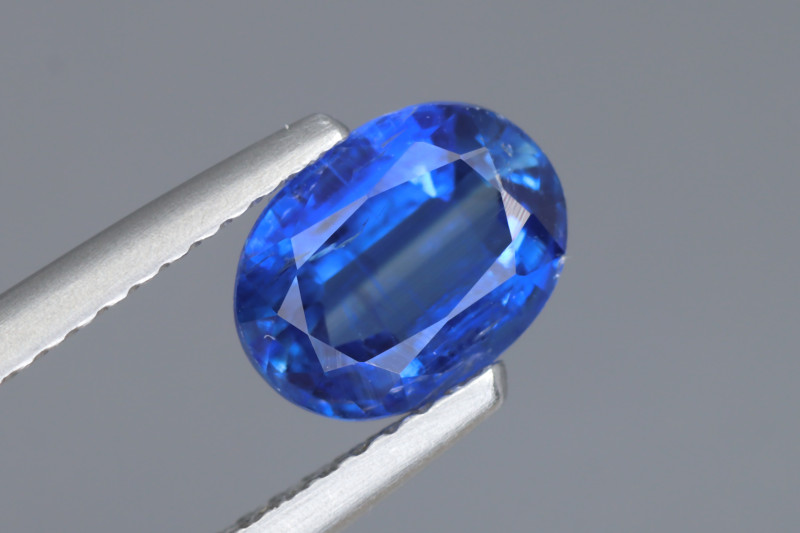
A relatively common mineral but rare gemstone, kyanite is most popular (and most commonly found) in blue colors. Kyanite blues range from pale to dark, and many specimens have stripes of white and blue shades, often with a deep blue streaking the crystal’s center.
Other terms for kyanite are “cyanite” and “disthene.” Industrial kyanite uses are abundant. The primary uses are in heat refractories (where ceramics are made) and making materials used for electronics.
Spiritually, blue kyanite is used for protection, strength, and communication.
Labradorite
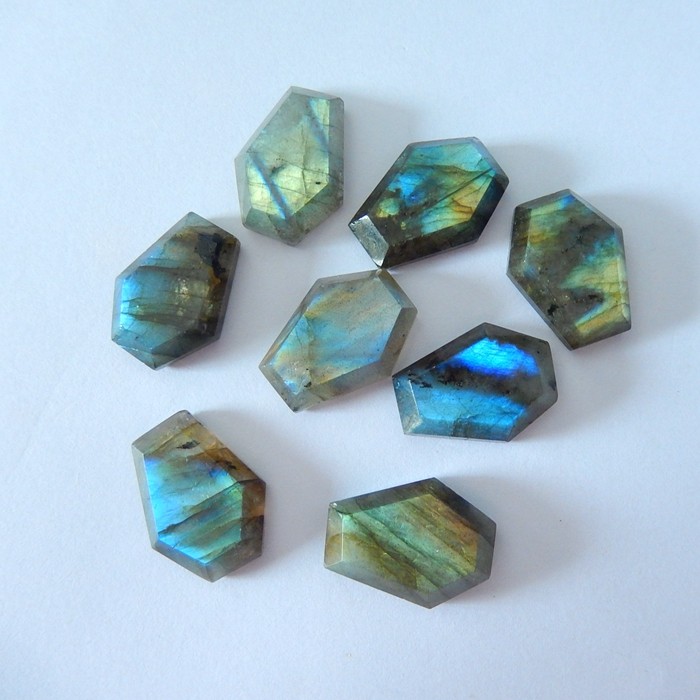
Labradorite is a spectacular feldspar variety distinguished for often displaying its eponymous labradorescence, a type of iridescence with multiple color flashes. Bright blues and oranges are the most common labradorite color flashes.
A variety known for being almost transparent with strong blue flashes is called “rainbow moonstone.” You can also see blue flashes, along with every other color in the rainbow, in the rare Finnish labradorite variety spectrolite.
Lapis Lazuli
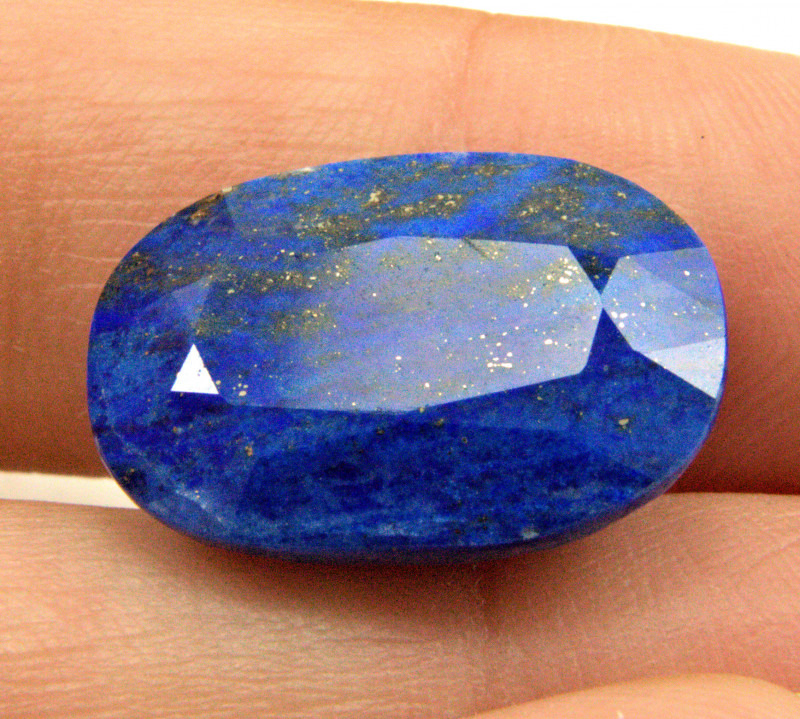
Lapis lazuli (or lapis) is a deep royal blue rock often speckled with white calcite and golden pyrite inclusions. The main mineral present is lazurite (or its variety hauyne), a deep ultramarine blue sodalite variety.
This stone is the original “blue,” as the source of the earliest known blue pigments dating back to cave paintings in present day Afghanistan circa 400 to 700 AD. For centuries, only ancient Egyptians knew how to produce this blue pigment; in fact, they were the only ancient culture with a word for “blue.”
The lapis pigment “ultramarine” gained European popularity around the 12th century, but cost more than gold. When more accessible, it became a phenomenon, particularly in Christian Renaissance paintings.
Today, lapis lazuli is a September birthstone and traditional 9th wedding anniversary gem.
Larimar
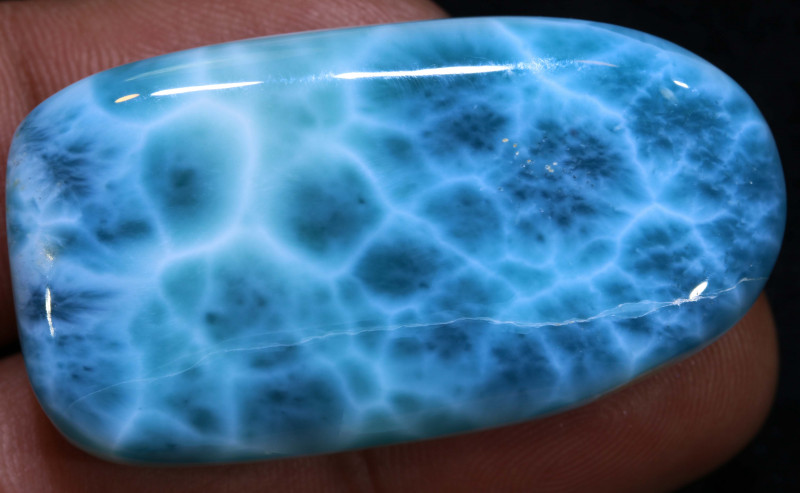
Joining the list of the rarest gemstones is larimar, a sea-green to light blue stone with white, cloudy patterns. Larimar is only found in the Dominican Republic. The most popular larimar color is sky blue, but the rarest, most valuable color is a deep blue called “volcano blue.”
Almost every larimar has a pattern, the best being deep blue with white ribbons. The most common is white lines or splotches of pectolite on a blue base.
If you’ve wondered what is the name of the baby blue gemstone?, it might be larimar, but it could be moonstone.
Moonstone

Moonstone is a commonly translucent feldspar variety that comes in a few different colors, but the best, most valuable types have a colorless base, no inclusions, and a medium blue sheen. This sheen or “flash” is called adularescence, which looks like the stone is glowing from within.
Given their value, are blue moonstones rare? While large, high-quality moonstones of any color are fairly rare, blue-flash moonstones are rarely larger than 15-20 carats. Beware: some dishonest sellers will label artificially blue-tinted chalcedony as “blue moonstone.”
Moonstones are alternative June birthstones and lucky Cancer sign talismans.
Blue Opal
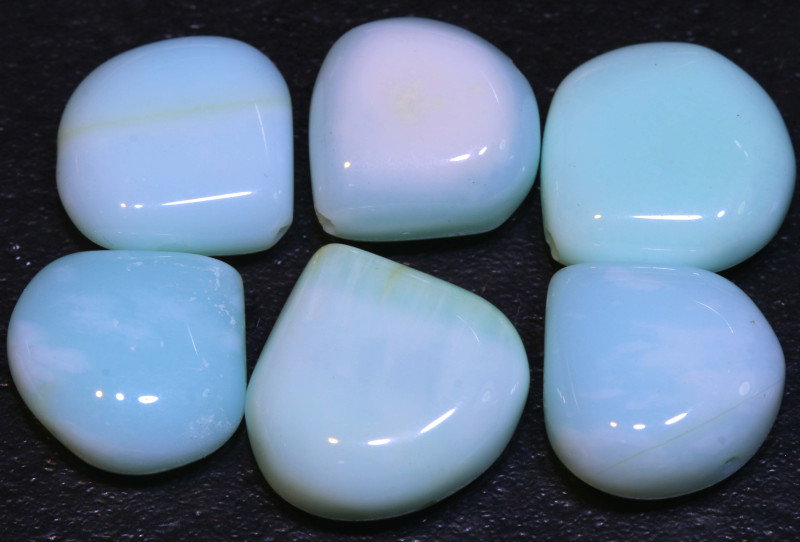
Besides being October birthstones and mineraloids (not minerals), opals are unique and vast in their varieties.
The two main categories are common opals (don’t have the iridescent-like play-of-color) and precious opals (do have play-of-color). Common opals are often less sought-after, but one exception is the blue common opal.
A famous example of highly-regarded blue common opal is the soft teal-colored Peruvian opal, the national stone of Peru. Another notable type is the Owyhee opals from Oregon, which have light to dark shades of muted blue.
All that said, precious opals can also be blue. The most valuable color, black opal, can sometimes have a dark blue body color that allows its rainbow of color-play to really shine.
Blue Pearls

This June birthstone is better-known for its ivory hues, but rarely, you’ll see natural blue in types of pearls like Akoya, Tahitian, or South Sea pearls.
The blues are usually overtones, ranging from silver-blue (South Sea) to sky blue (Akoya) to midnight blue (Tahitian). The uniquely shaped Abalone pearls also display blue iridescence.
Besides standing out as organic gemstones, blue pearls are quite rare. They join gold pearls as the rarest natural colors.
Pietersite
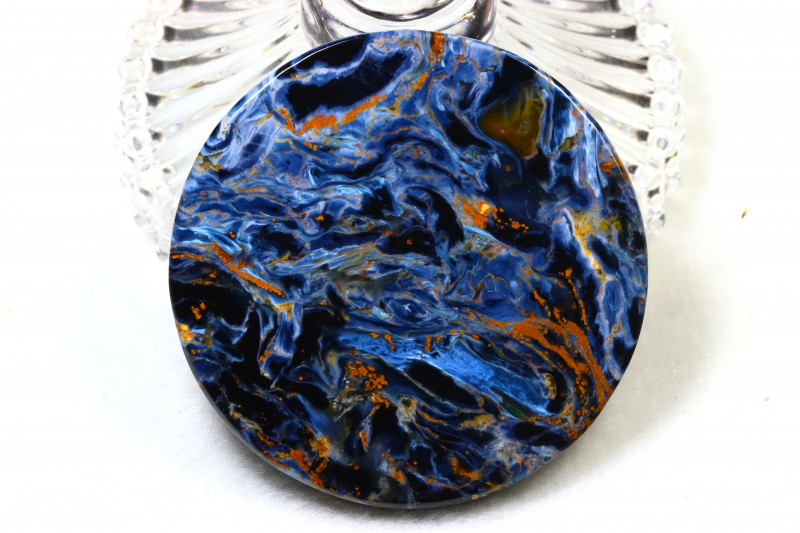
Pietersite is a multi-colored stone often called “eagle’s eye.” The patterned chalcedony aggregate contains quartz cementing fragments of hawk’s eye and tiger’s eye (usually), creating a predominantly blue, gold, and red display.
Every pietersite has a unique pattern and color combination, though blue and brown are the predominant colors. Like its fellow “eye” stones, pietersite has simple chatoyancy. It was a recent discovery in Namibia in 1962.
Blue Sapphire
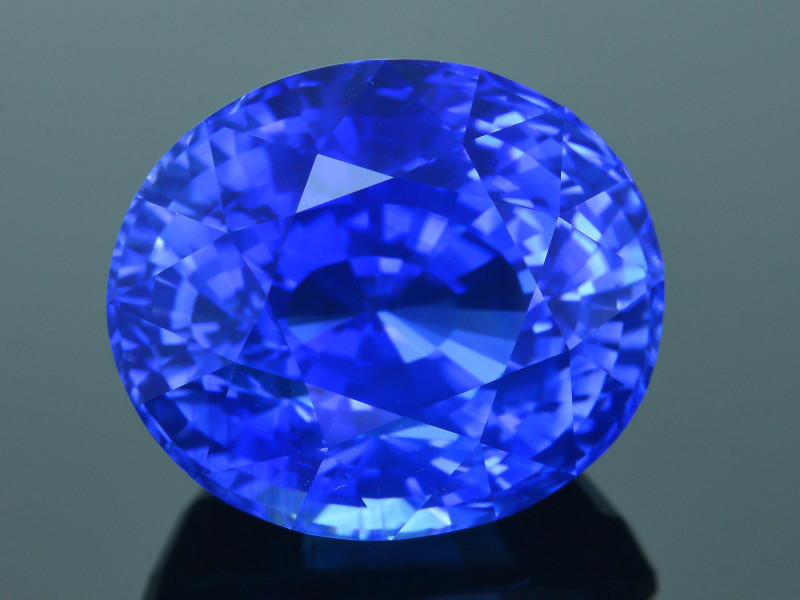
Arguably the most famous blue gemstone is sapphire, the corundum variety recognized as THE royal blue gemstone throughout history. While sapphires come in every color but red (that’d be ruby), blue sapphires are the most popular and most valuable.
The best blue sapphires are cornflower blue and Kashmir, which is also cornflower blue but velvety and exclusively sourced from the Himalayas.
Other notable types of blue sapphire:
Star Sapphire: Displays a reflected multi-rayed “star” of light; Most are black, pink, or blue, with top-quality blue being highest-value
Mermaid or Peacock Sapphire: Teal sapphire with a 50-50 ratio of blue and green
Color-Changing Sapphire: Most commonly shift from blue or purple in daylight to violet or reddish-purple under incandescence; Misnomered as “blue alexandrite”
What is so special about blue sapphires? Besides their history and diversity, blue sapphires are durable stones, serving as the most common engagement ring center stone in the US before diamonds became standard.
Shattuckite
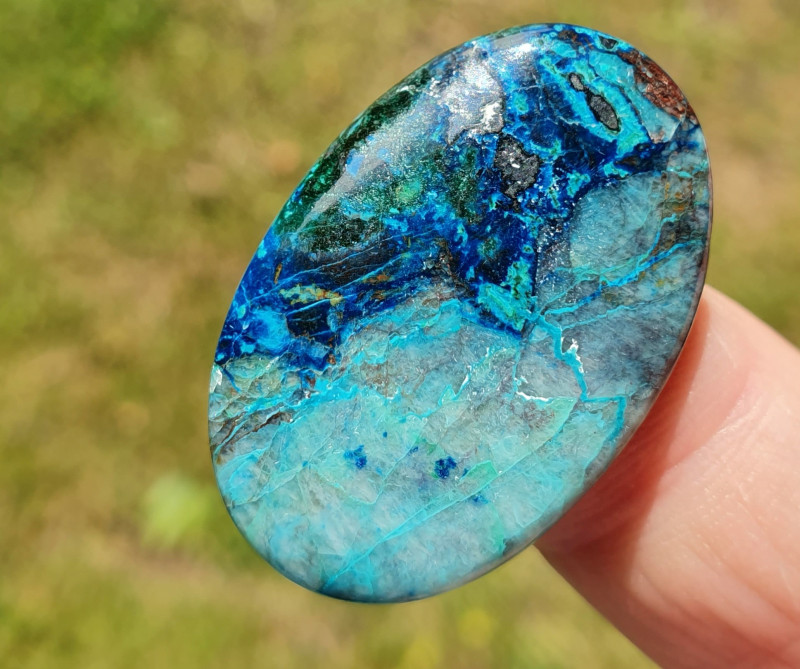 Pictured above: Blue shattuckite cabochon with azurite, malachite, chrysocolla, and cuprite
Pictured above: Blue shattuckite cabochon with azurite, malachite, chrysocolla, and cuprite
Named for its discovery at the Shattuck Mine in Arizona, USA, shattuckite is a copper gem known for its green or blue shades, ranging from navy to rich cobalt blue. Specimens from Congo may be called “Lunazul.”
Shattuckite specimens are usually mixed with other stones like quartz, malachite, azurite, or chrysocolla. Chrysocolla vs shattuckite is also a difficult distinction often requiring a professional analysis. Many shattuckite cabochons are mottled with different shades of blue, green, and gray or black.
Sodalite

Wondering what stone resembles lapis lazuli? It’s probably sodalite, an affordable denim, Prussian blue, or violet-blue stone often with white and/or brown patterns. In terms of sodalite vs lapis lazuli, the latter is a rock (not a mineral) and contains the sodalite variety lazurite.
Technically, “sodalite” is a group of minerals. Some sodalite minerals, like hackmanite, are tenebrescent, meaning they change color in the sun and revert back in the dark.
Blue Spinel
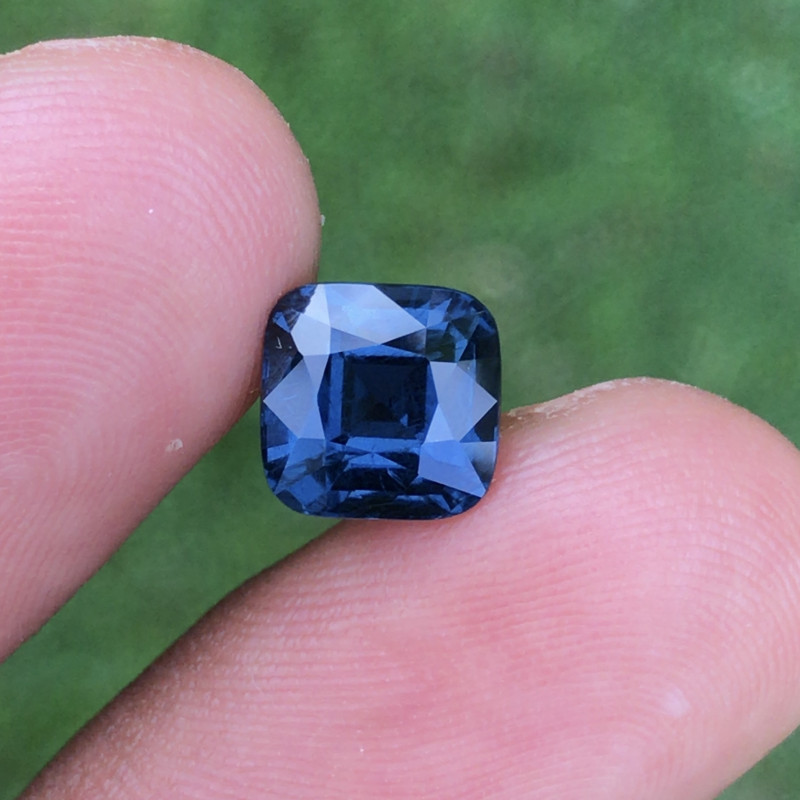
The newest addition to standardized birthstones (added for August in 2016), spinel is found in an array of bright colors. It was historically mistaken for precious rubies and sapphires, but has many worthy blue varieties of its own:
Gahnospinel: Blue and dark blue blend of spinel and gahnite
Pleonast: Dark blue, black, or green opaque variety
Alexandrite Spinel: Color-changing variety that’s grayish-blue in daylight and violet under incandescence; Note: distinct from alexandrite
Top-quality blue spinels are cobalt blue, which can also be manufactured as flame fusion or flux grown synthetics.
Now, what gem is blue and purple?
Tanzanite

Tanzanite is a blue, purple, or violet-blue epidote variety only found in Tanzania. The gem is rare already, but naturally blue specimens are extremely rare, so most blue tanzanites have been heat-treated.
Should tanzanite be blue or purple? It can be either, but its intense pleochroism means many faceted tanzanites will be blue and purple at different angles.
Like spinel, tanzanite is a recent birthstone addition but for December.
Blue Topaz
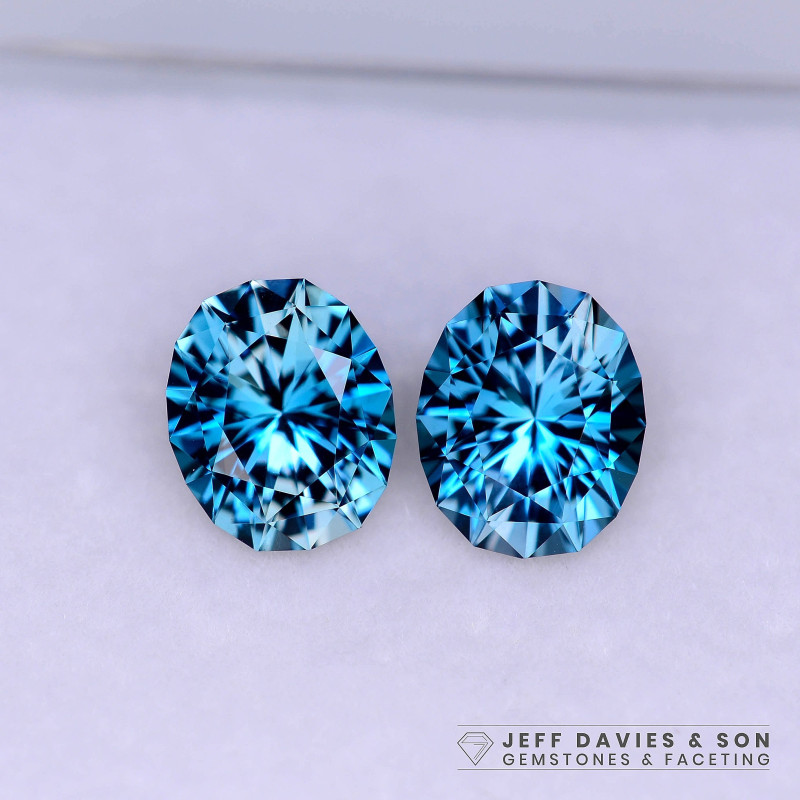 Pictured above: Custom cut London blue topaz gemstones
Pictured above: Custom cut London blue topaz gemstones
Another wintery December birthstone is blue topaz! This topaz is a much more abundant, affordable alternative to tanzanite or blue sapphire.
There are some different shades of blue topaz to know, many of which are treated:
London Blue: Deep grayish- or steel-blue; Usually priciest; Sometimes natural, usually heat-treated
Swiss (Electric) Blue: Light neon blue; Heat-treated
Sky Blue: Paler blue to greenish-blue; Often irradiated; Common alternative to aquamarine
Blue Center-Fused Topaz: Saturated medium blue; Result of diffusion and HPHT treatment
Another variety created with treatments is mystic topaz, which has an iridescent coating of blues, purples, and greens.
Blue Tourmaline
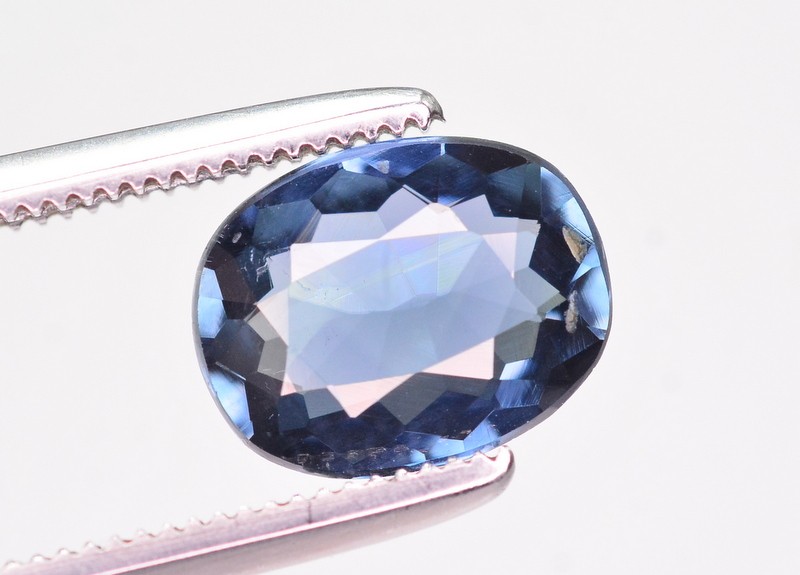 Pictured above: Indicolite tourmaline
Pictured above: Indicolite tourmaline
Tourmaline has three main species: schorl, dravite, and elbaite. Elbaite has the most gem-quality varieties, and two of these elbaite varieties are blue: indicolite and Paraiba tourmaline.
Indicolite has light to dark blue, greenish-blue, or blue-green coloring from iron impurities. Paraiba tourmaline has super vibrant neon-blue, blue-green, or violet shades from copper impurities.
Paraiba tourmaline is rarer, brighter, and significantly more valuable than indicolite. However, both are still October birthstones and Libra talismans.
Turquoise
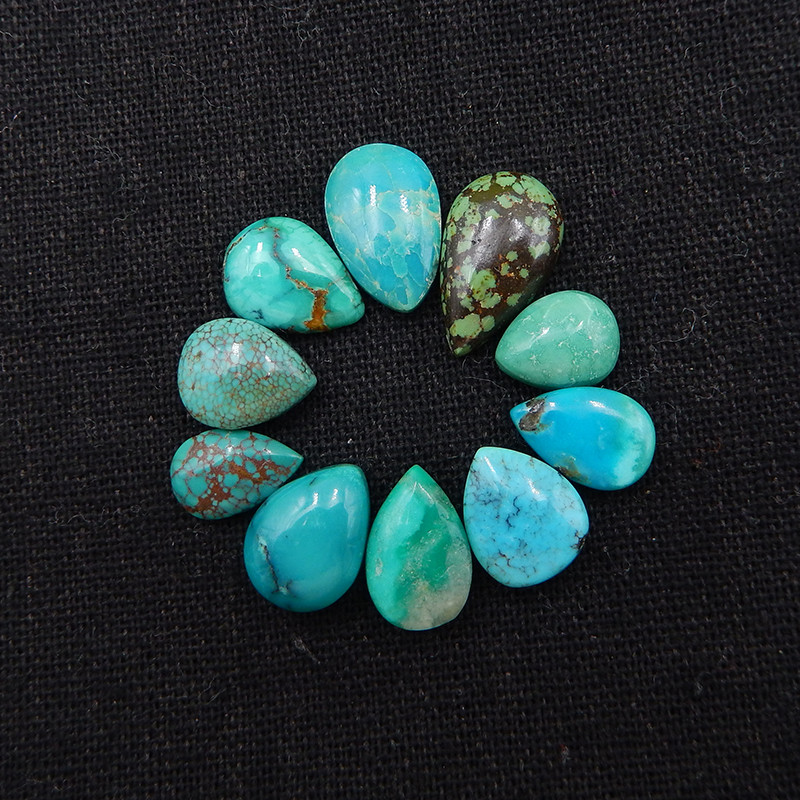
Turquoise is a commonly opaque, greenish-blue often found with yellow or brown veining. The name derives from the French turquois, meaning “Turkish,” because Europeans obtained the stone through Turkish trade routes.
The characteristic green and blue color mixture inspired the color “turquoise.” However, turquoise stones can actually range from bright blue to green.
Be aware: many lower-quality turquoise stones are dyed or stabilized to have a better color. Other stones may be sold as imitations, many of which are dyed howlite or dyed magnesite, two naturally white stones with webbing or veining patterns similar to that of turquoise.
Blue Zircon

Capping off our list is the underrated blue zircon, a natural stone commonly confused with the synthetic cubic zirconia. Besides being the oldest known substance on Earth, zircon is also impressive for having a higher dispersion than diamond at a fraction of the cost.
The most popular color, electric blue zircon, commemorates December birthdays and 4th wedding anniversaries. Blue zircons can be natural, but they’re often heat-treated to be blue.
From Sky to Sea, Blue Gemstone Options are Abundant!
The diversity of blue gemstones is vast. With various undertones, saturation levels, and price points, you’re sure to find the perfect blue companion for you!
Browse hundreds of blue gemstones at Gem Rock Auctions today!
Search the Gemstone Encyclopedia
Related Auctions
Related Articles
Everyone has a gemstone that corresponds with their star sign. These are also known as your Star Stone. Learn more about these stones and find out what your Star Stone is.
10th May 2018
Originally the Birthstones or gemstones were associated with a zodiac sign or the month of a individuals birth. Find out what your stone is and view the stones we have for sale
8th Feb 2021
There are so many tools on the market for testing a gemstone, but what are the main tools required for simple analysis. Lets look at four tools for gemstone testing.
4th Mar 2020
Latest Articles
Yugawaralite is a rare colorless, white, or pinkish zeolite crystal named for its discovery in Yugawara, Japan. Here we uncover the multifaceted history, properties, prices, and uses of yugawaralite.
24th Mar 2025
Simpsonite is a lesser-known mineral known on the gem market for its durability, yellow-orange color, and rarity. Discover all the properties, uses, prices, and history of simpsonite.
3rd Mar 2025
Kurnakovite is a colorless crystal related to inderite and rarely faceted but known among collectors. Explore the mineral traits, history, prices, and more in this kurnakovite guide.
17th Feb 2025
Article Categories
How To's is where you will find helpful articles from gem Rock Auctions on how to cut gemstones, select gemstones and buy gemstones.
9 Articles








